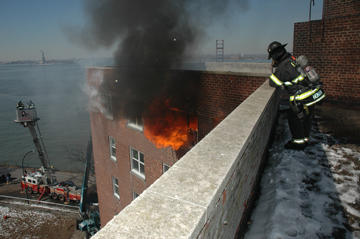
Fire researchers at the National Institute of Standards and Technology (NIST) have just published two reports providing details of how wind affects fires in high-rise buildings. A set of instructional DVDs based on the research is available for firefighter training, and will lead to improved safety for civilian and firefighters.
While much is known about wind's impact on outdoor blazes, little has been known about how a fire rapidly turns into a "blowtorch" —firefighter's parlance—when a blast of wind enters through a broken window, particularly in high-rise buildings.
Thousands of high-rise apartment fires occur annually. Beginning in one room, a fire can quickly spread smoke, heat and gases through hallways and stairwells, limiting the occupants' chances to escape and the firefighters' ability to rescue them. NIST researchers conducted a series of experiments to study the effect of wind on high-rise fires—buildings seven stories and taller—and potential techniques for fighting these fires.
Eight experiments were conducted in NIST's Large Fire Laboratory, where conditions were controlled and measured. "These tests demonstrated that wind and a simple room and contents' fire can be extended when wind and an open vent are present," explained Fire Protection Engineer Dan Madrzykowski. "The temperatures in the flow path reached at least 400 degrees C (752 degrees F)—far higher than a firefighter in full protective gear can survive," said Madrzykowski.
The researchers also conducted field experiments in an abandoned seven-story building on Governors Island, New York. The results confirmed the laboratory findings—that conditions created by wind can push hot gases and smoke from the apartment of origin into the public corridors and stairwells.
Researchers experimented with techniques that had a significant impact on reducing the hazardous conditions. For example, firefighters placed a fire-resistant material over windows to block the wind. They also used a "floor below nozzle" that allowed them to spray water through a broken window from the apartment below. The importance of controlling the doors inside a building to interrupt the flow path and stop the spread of fire gases was demonstrated many times during the experiments.
The laboratory tests that NIST and the Fire Protection Research Foundation conducted are described in NIST Technical Note 1618, "Fire Fighting Tactics Under Wind Driven Conditions: Laboratory Experiments".
The field study, in which NIST teamed with the Fire Department of New York City and the Polytechnic Institute of New York University, is reported in NIST Technical Note 1629 "Fire Fighting Tactics Under Wind Drive Fire Conditions: 7-Story Building Experiments." (http://fire.nist.gov/bfrlpubs/fire09/PDF/f09015.pdf).
Both projects were supported by the Department of Homeland Security's Federal Emergency Management Agency Assistance to Firefighter Research and Development Grant Program and the United States Fire Administration.
A double DVD set on the research is available for teaching purposes. It includes a video overview, both reports, a PowerPoint presentation summarizing the results, training videos, and video documentation of all of the experiments. The information is available at www.fire.gov. The DVD set can be ordered by emailing a request to madrzy [at] nist.gov (madrzy[at]nist[dot]gov).

